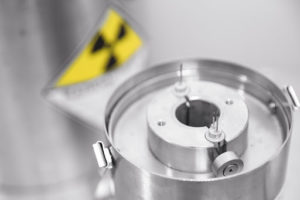APPLICATIONS OF TECHNOLOGY:
- Pharmaceutical isotope production
- Water purification
- Nuclear waste treatment and portable analysis
- Production of radiation sources
ADVANTAGES:
- Improved performance and reliability
- Versatile process
- Separates different metal ions under soft conditions
- Scalable and operable at room temperature
BACKGROUND:
Current available methods for separation and purification of metal ions are either hydrometallurgical processes (liquid-liquid extraction, precipitation, electrodeposition, etc.) or analytical techniques (high performance liquid chromatography, ion chromatography, impregnated resins, capillary electrophoresis, mass spectrometry, etc.). Such hydrometallurgical processes are operated at ambient or low pressure but require harsh chemical conditions and multiple steps in order to reach the desired purity. Their recovery yield also rarely reaches 100%. Furthermore, the analytical techniques convey very little quantities, are operated at very high pressure (such as in HPLC methods) or very low pressure and high temperature (as in mass spectrometry techniques) and they are difficult to scale at the industrial level. Both hydrometallurgical and analytical methods often require the use of organic solvents, either hydrosoluble or hydrophobic.
TECHNOLOGY OVERVIEW:
This invention provides a new approach to the separation or purification of metal ions that enables simpler and more efficient industrial processes. This process uses siderocalin (or other proteins) as a platform for the separation of metal ions. Siderocalin is able to bind various charged metal complexes through electrostatic interactions. While siderocalin binds tightly to negatively charged complexes, it doesn’t bind to neutral complexes due to a lack of electrostatic interactions. The protein-ligand system therefore acts as a sorting device at a molecular level, due to the formation of high-molecular species (Protein-ligand metal adduct) versus low-molecular weight species (ligand-metal complex that is not recognized by the protein).
The low-molecular weight ligand can be tuned to match the charge of the metal ions to separate it from high-molecular species. The separation is based on various fundamental characteristics such as differences in size, mass, polarity, solubility, etc. Hence, the separation of the metal-ligand protein adducts from the low-molecular weight species can potentially be performed by various techniques such as (among others) size exclusion chromatography, cut-off filter filtration, solid-liquid extraction using solid supports grafted with the protein or the protein-ligand adduct, tangential filtration, ultra-, micro- or nano-filtration and liquid-liquid extraction.
This invention poses the benefit of being fast, efficient, scalable and operable at room temperature, ambient pressure, and in fully aqueous solvent.
DEVELOPMENT STAGE: Proven principle
STATUS: Available for licensing or collaborative research.
SEE THESE OTHER BERKELEY LAB TECHNOLOGIES IN THIS FIELD:
Selective Complexation and Separation of Tetravalent Metal Ions from Other Ions 2017-107
HOPO Ligands to Separate and Purify Metal Ions including Lanthanides and Actinides, 2017-106
Decorporation Agent for Therapeutic Chelation of Industrial and Clinical Toxic Heavy Metals 2016-078

